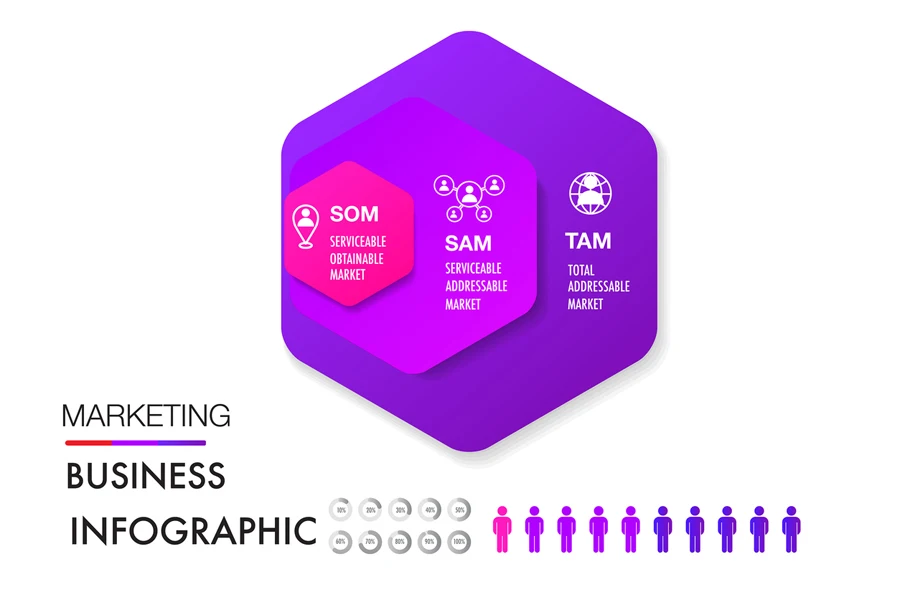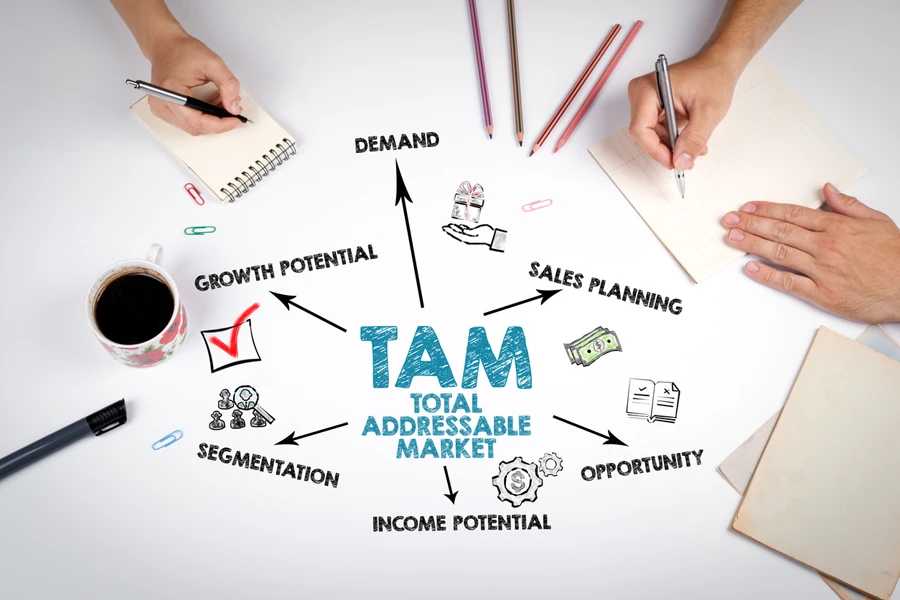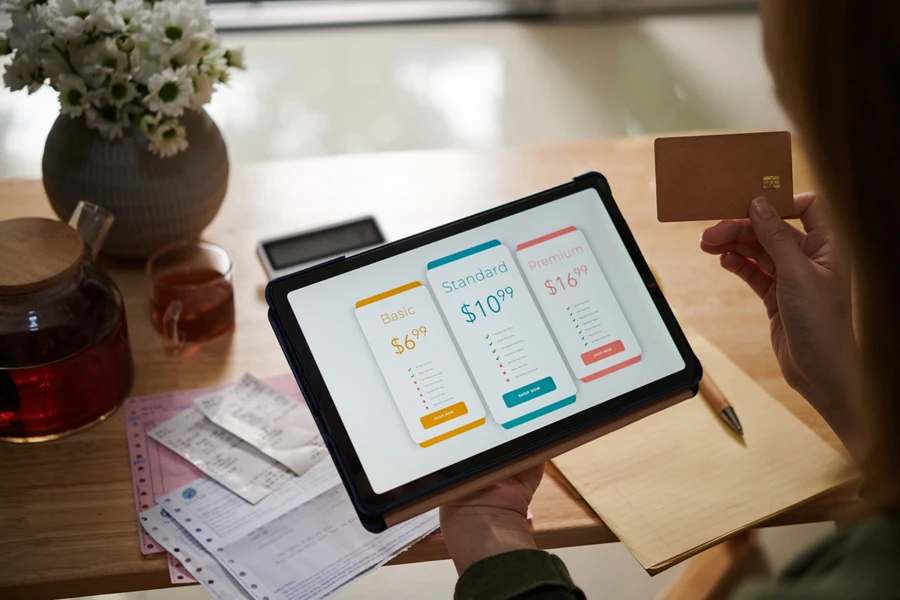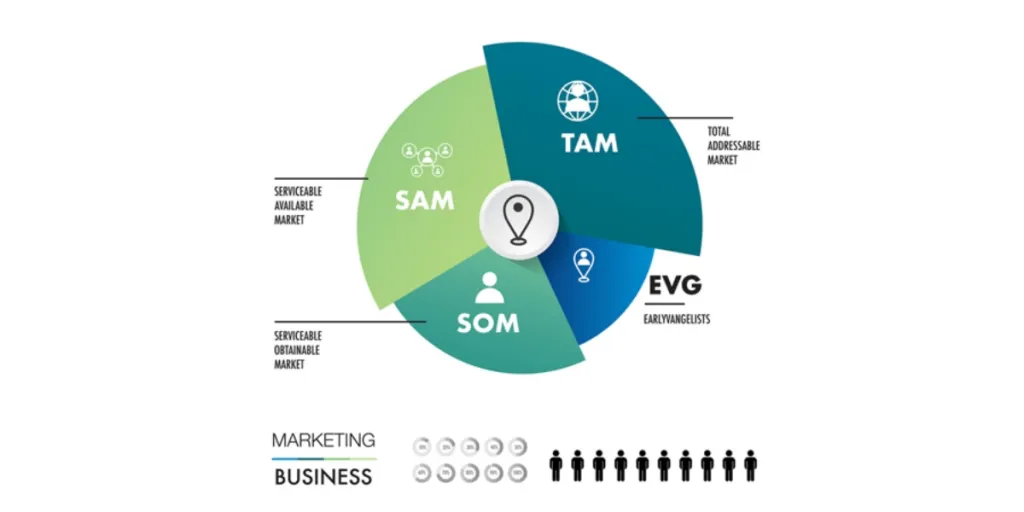Traditional marketers often sit at their desks and run numbers, always calculating to see whether a transaction will aid or hobble their business. Running campaigns like this is where TAM, SAM, and SOM – total addressable market, serviceable available market, and serviceable obtainable market – are some of the most crucial metrics to consider.
However, marketers are not the only ones who can utilize these metrics for leverage. Business owners, and even product teams, can use them to forecast the potential of various operations or the viability of new offerings.
Too significant to ignore, businesses must use TAM, SAM, and SOM to calculate everything from profitability to realistic revenue goals. Here, we’ll explain their meaning, how to calculate them, and how best to use them for business success.
Table of Contents
The importance of TAM, SAM, and SOM
What is and how to calculate total addressable market (TA)?
What is and how to calculate serviceable available market (SAM)?
What is and how to calculate serviceable obtainable market (SOM)?
5 steps to help businesses best use TAM, SAM, and SOM
Bottom line
The importance of TAM, SAM, and SOM

TAM, SAM, and SOM are crucial for business plans and growth strategies. These metrics can help understand how profitable a market will be at different stages of a business plan. Via a few simple calculations, businesses can get a clear snapshot of their target audience and income opportunities, making it easier to propose an idea’s value to teams or investors.
These metrics are so interconnected that one influences the other. For instance, if a business doesn’t define its serviceable available market, it may overestimate it, leading to an unrealistic share obtainable market). Hence, accurate TAM, SAM, and SOM insights can result in smoother decision-making and more realistic growth forecasts.
What is and how to calculate total addressable market?

Total addressable market, or TAM, is the total demand in a given market. This metric aims to calculate the most revenue a business could make if able to capture the entire market.
TAM also helps retailers understand the target market’s growth potential as well as how well a product will fit in the market and gauging if businesses have room to grow and succeed.
How to calculate TAM
Before businesses calculate their TAM, they will need two things:
- Total potential customers: How many people or businesses are likely to need the product or service
- Average annual revenue per customer: How much each customer will likely spend on the product or service yearly
Calculating TAM require multiplying these two numbers together:
Total potential customers) x
Average annual revenue per customer = TAM
Example
Let’s say a business is launching a subscription-based fitness app. Here’s what they would do to calculate the TAM:
- Potential customers: Approximately 8 million fitness enthusiasts are interested in at-home workout solutions
- Average revenue per customer: US $200 annually
So the TAM calculation would be:
8,000,000 X 200 =US $1,600,000,000
In this case, the fitness app’s TAM is US $1.6 billion. However, remember that this estimate can change with market trends, competition, and shifting customer preferences.
What is and how to calculate serviceable addressable market (SAM)

Because of factors like business focus or geographic restrictions, companies can only serve part of their total addressable market (TAM). That’s where serviceable addressable market, or SAM, comes in. SAM helps to narrow down the portion of TAM that businesses can realistically reach, making it easier to set revenue and marketing goals when tapping into the market.
How to calculate SAM
Here are three things businesses must have before calculating SAM:
- Total available market: This number could be the entire TAM or a smaller group likely to use the product or service
- Percentage you can serve: A realistic share of customers the business can handle based on their capacity
- Expected revenue per customer: How much businesses expect each customer to spend on their product or service annually
Getting the SAM requires multiplying these numbers together:
Total available market x
Percentage you can serve) x
Expected revenue per customer = SAM
Example
Following the example of a subscription-based fitness app, here’s how that business will calculate SAM:
- Potential customers: 8 million fitness enthusiasts
- Percentage you can serve: 20%
- Expected revenue per customer: US$300 annually
The SAM calculation will be:
8,000,000 x 0.2 x 500 = 800,000,000
The SAM for the subscription-based fitness app market is therefore US $800 million. This gives businesses a clearer view of the market they can realistically target, helping them prioritize growth and allocate resources effectively.
What is and how to calculate serviceable obtainable market (SOM)
Unless businesses are the only option in the market, capturing 100% of the serviceable addressable market is nearly impossible. Even with just one competitor, convincing everyone to choose only one product or service will be challenging.
It therefore helps businesses to calculate their serviceable obtainable market (SOM), estimating how many customers will likely choose their offering and giving them a more realistic and accurate picture of the potential reach.
How to calculate SOM
Businesses will need three things before calculating SOM:
- Percentage of customers you can serve: This number refers to the portion of potential customers the business can handle with its current setup
- Percentage of the market you can capture: This number is the slice of the market businesses expect to win over, factoring in competition and market conditions
- Average annual revenue per customer: The yearly income businesses expect to earn from each customer
The formula to calculate SOM is therefore:
TAM x
Percentage of customers you can serve x
Percentage of market you can capture x
Average annual revenue per customer = SOM
Example
Following the example of a subscription-based fitness app, imagine the business is launching in a city with 8 million potential customers (TAM). Here’s what its SOM will look like:
- Customers you can serve: 20%
- Market share capturable: 4%
- Average revenue per customer: US $500 annually
And the SOM calculation:
8,000,000 x 0.2 x 0.04 x 500 = US $32,000,000
Hence, the SOM for the subscription-based fitness app will be US $32 million. This metric helps to calculate a more realistic sales and growth target.
5 steps to help businesses use TAM, SAM, and SOM
1. Define the target market

Before diving into TAM, SAM, and SOM, businesses must define their market and what they want to offer. It could be a service, product, or product line. They can start by clarifying who the audience is. Think about details like:
- Geographic location
- Gender
- Age group
- Key traits
- The problem the product or service addresses
Note: The more specific businesses are, the easier they can calculate their market potential.
2. Use TAM to discover the total market size
Next, it’s time for some market research. Businesses must decipher how many potential customers are in their target market and estimate the revenue if each one was to purchase a product.
For instance, if the abovementioned subscription-based fitness app targets women between 20 and 45, businesses can start by determining how many women in their given market fall into that range. Then, they can calculate how much revenue they would make if all those women subscribed to the app.
3. Use SAM to calculate potential market size

In the example above, imagine the business is focused on offering high-end workout sessions for women in the U.S. First, it would check how many women are within the target age range (20 to 45 in this case) in the U.S. Using this, it is then able to calculate the potential revenue if all those women subscribe to its app.
4. Use SOM to find potential attainable market share
Women living paycheck to paycheck probably won’t be interested in a high-end subscription service, and those who live busy lives are less likely to be the target audience for the example business.
So, estimating the SOM will require narrowing down the target market based on factors like income and job type. Afterward, businesses can refine the calculation further by considering how much of that market they can capture, taking competition into account.
5. Understand the opportunities and challenges

With calculations in hand, it’s time to analyze the data and plan the next steps. Start by asking the following questions:
- What’s happening in the market right now?
- What are the competitors doing well, and where are they falling short?
- Are there any gaps or unmet needs in the market?
- Are there any overlooked segments?
Once the answers to these questions have been determined, marketing strategies can be developed in a way that focuses on the business’s strengths, helping to reach their target audience effectively.
Bottom line
It’s easy to think of TAM, SAM, and SOM as business jargon and overlook them as complex calculations. However, to do so is to potentially harm your harm your business, and they should be the core part of any business strategy. That’s because they help form estimates around outputs and gauge potential before tapping into the market.
Nowadays, discovering market opportunities is not enough; businesses can use insights garnered from TAM, SAM, and SOM to decide who their target audience is and how they can most effectively engage them with their products.




